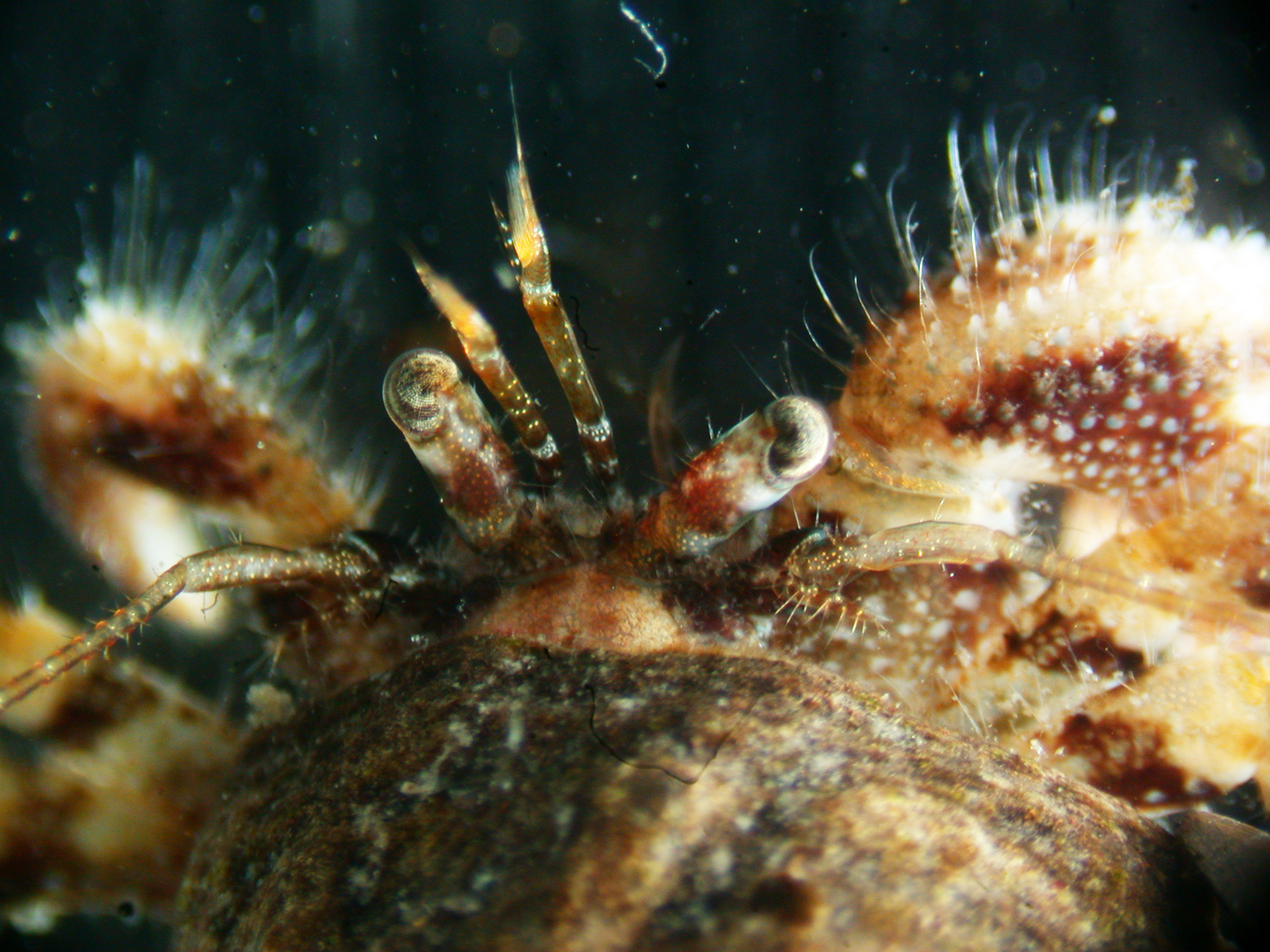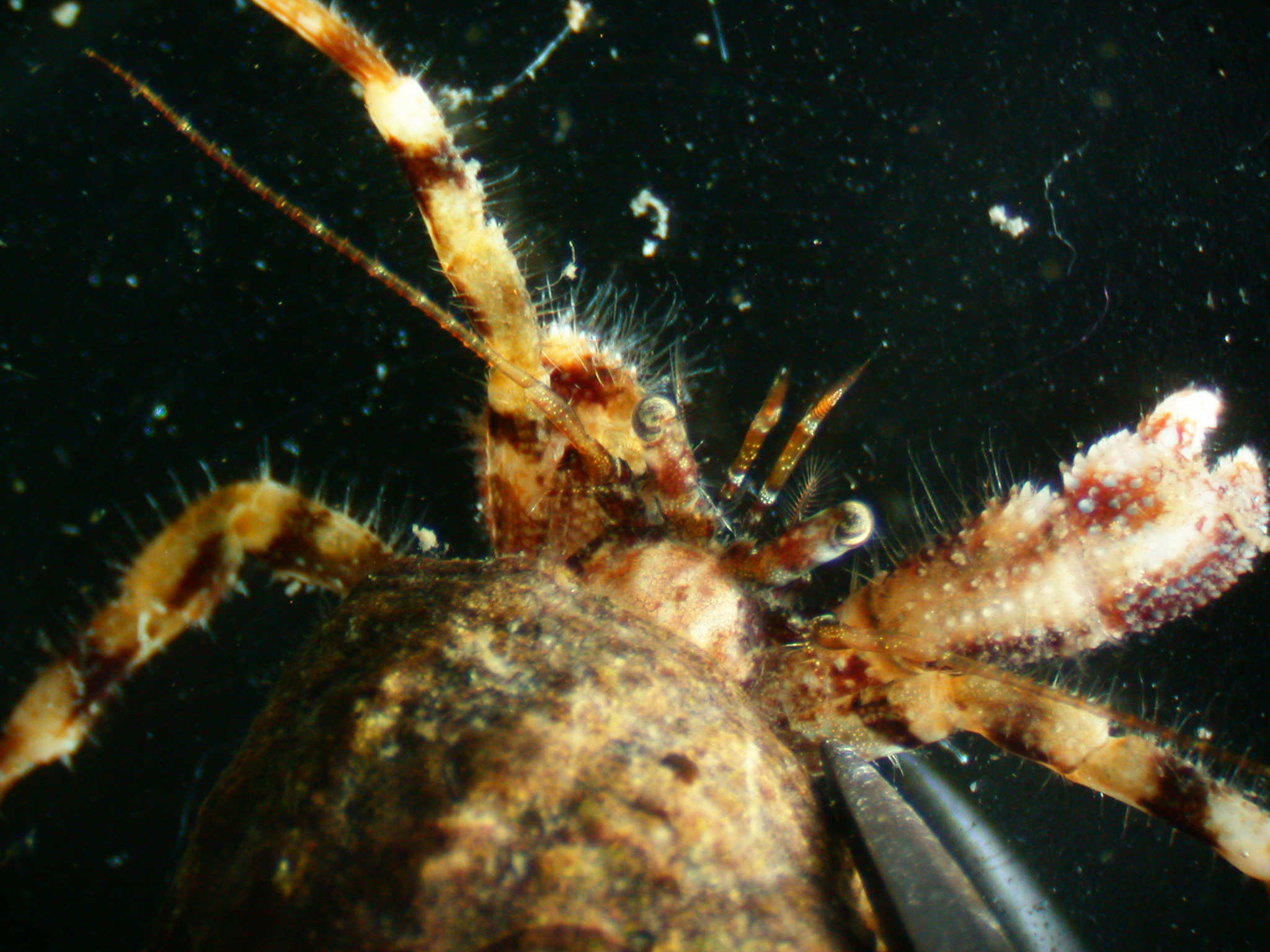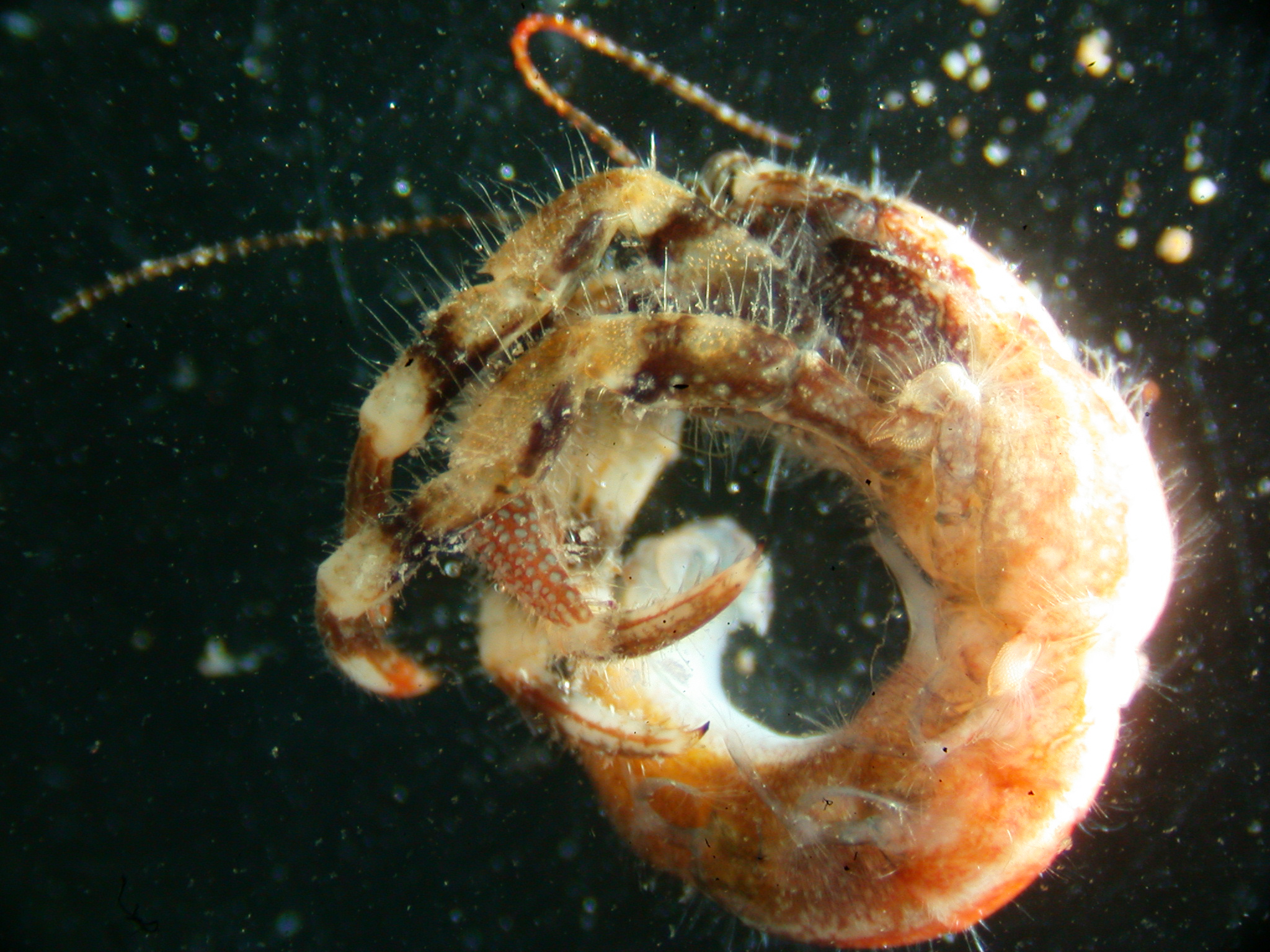Report of Systematic Zoology Lab Practicum, July, 2012
28S rDNA partial sequence of Pagurus minutus (Decapoda: Anomura: Paguridae)
Misato Seki and Syunsuke Togawa
Division of Biology, Department of Biological Sciences, School of Science, Hokkaido University, Sapporo 060-0810, Japan
Material and Methods
A hermit crab was obtained among laminarian holdfasts in Oshoro Bay, Hokkaido, Japan, about 43°12’N, 140°51’E, on 4 June 2012 by Misato Seki and Syunsuke Togawa , photographed and identified by Hiroshi Kajihara as Pagurus dubius (Ortmann, 1892) based on Hieda and Takahashi (1986); the species is now regarded to be a junior synonym of Pagurus minutus Hess, 1865 (McLaughlin et al. 2010). DNA was extracted from one of the legs, using the silica method (Boom et al. 1990) with some modifications. Extracted DNA was dissolved in 30 µl of deionized water and has been preserved at –20°C. Remaining morphological voucher specimen has been deposited at the Hokkaido University Museum under the catalogue number ICHU22100134 (contact: Dr. Hiroshi Kajihara, kazi@mail.sci.hokudai.ac.jp).
Amplification of mitochondrial cytochrome c oxidase subunit I gene (COI) using LCO1490 (5′-GGTCAACAAATCATAAAGATATTGG-3′) and HCO2198 (5′-TAAACTTCAGGGTGACCAAAAAATCA-3′) (Folmer et al. 1994) was unsuccessful.
An about 1.2K-bp fragment of 28S rRNA gene was amplified by polymerase chain reaction (PCR) using LSU5 (5′-ACCCGCTGAAYTTAAGCA-3′) and LSU3 (5′-TCCTGAGGGAAACTTCGG-3′) (Littlewood 1994). A hot start PCR was performed by a thermal cycler, DNA Engine, in a 20-µl reaction volume containing 1 µl of template total DNA (approximately 10–100 ng) and 19 µl of premix made with 632-µl deionized water, 80-µl Ex Taq Buffer (TaKara Bio), 64-µl dNTP (each 25 mM), 8-µl each primer (each 10 µM), and 0.1-µl TaKara Ex Taq (5 U/µl, TaKara Bio). Thermal cycling condition comprised an initial denaturation at 95°C for 30 sec; 30 cycles of denaturation at 95°C for 30 sec, annealing at 45°C for 30 sec, and elongation at 72°C for 45°C and a final elongation at 72°C for 7 min.
The PCR product was purified with the silica method (Boom et al. 1990). Both strands were sequenced with a BigDye® Terminator v3.1 Cycle Sequencing Kit (Applied Biosystems) following the manufacturer's protocol, using the same primer set as the initial PCR amplification. Sequencing was performed with ABI Prism 3730 DNA Analyzer (Applied Biosystems). Chromatogram and sequence data were operated with MEGA 5 software (Tamura et al. 2011).
Results
A total of 1277 bp of 28S rDNA sequence was determined from ICHU22100134, identified as Pagurus minutus Hess, 1865 (see Appendix).
Taxonomy
Phylum Arthropoda
Class Malacostraca
Order Decapoda
Family Paguridae
Genus Pagurus Fabricius, 1775
Pagurus minutus Hess, 1865
(Figs 1–3)

Fig. 1. ICHU22100134, identified as Pagurus minutus Hess, 1865, magnification of head, dorsal view.

Fig. 2. ICHU22100134, identified as Pagurus minutus Hess, 1865, dorsal view.

Fig. 3. ICHU22100134, identified as Pagurus minutus Hess, 1865, lateral view.
References
Boom, R., Sol, C. J. A., Salimans, M. M. M., Jansen, C. L., Wertheim-van Dillen, P. M. E., and van der Noordaa, J. 1990. Rapid and simple method for purification of nucleic acids. Journal of Clinical Microbiology 28: 495–503.
Folmer, O., Black, M., Hoeh, W., Lutz, R. and Vrijenhoek, R. 1994. DNA primers for amplification of mitochondrial cytochrome c oxidase subunit I from diverse metazoan invertebrates. Molecular Marine Biology and Biotechnology 3: 294–299.
Hieda, K. and Takahashi, Y. 1986. Hokkaido Umibeno Ikimono [Marine Organisms in Seashores around Hokkaido]. Hokkaido Shinbun-sha, Sapporo. 294 pp [In Japanese]
Littlewood, D. T. 1994. Molecular phylogenetics of cupped oysters based on patial 28S rRNA gene sequences. Molecular Phylogenetics and Evolution 3: 221–229.
McLaughlin, P. A., Komai, T., Lemaitre, R. and Rahayu, D. L. 2010. Annotated checklist of anomuran decapod crustaceans of the world (exclusive of the Kiwaoidea and families Chirostylidae and Galatheidae of the Galatheoidea) part I—Lithodoidea, Lomisoidea and Paguroidea. The Raffles Bulletin of Zoology, Supplement 23: 5–107. [National University of Singapore]
Tamura K, Peterson D, Peterson N, Stecher G, Nei M, Kumar S. 2011. MEGA5: Molecular evolutionary genetics analysis using maximum likelihood, evolutionary distance, and maximum parsimony methods.
Molecular Biology and Evolution 28: 2731–2739.
Appendix
Partial sequence of 28S rDNA (1277 bases) from ICHU22100134, identidied as Pagurus minutus Hess, 1865.
TCAGTAAGGGCGACTGAAATGGGAAGAGCCCAGCGCATAAGCTCGCTTTGCCTTTTACCGGGCGCGAGCGGTGTTGCGTTTCGGAGGGTCCGGCACACTGCCTCACGACGCCTAAGTCATGTTTGAAAGCGGCCACTACCCATTGAGGGTGAAAGGCCCGTCTGGCGGAGCCCGTGAGGGCAGAAGTGAGGCGGTCGGAAAGGACCTATCCGTAGAGTCGGGTTGCTTGAAAGTGCAGCCCAAAGCAGGTGGTAAACTCCATCTAAGGCTAAATATGACCACGAGACCGATAGCGAACAAGTACCGTGAGGGAAAGTTGAAAAGAACTTTGAAGAGAGAGTTCAAGAGCACGTGAAACCGTTAAGAGCCAAACGGGTGGAACTCGTAGATCGAACTGAGGGGATTCAGCTCGTCGGCAGGGGCTGGGGCGGTTGGTGGATGATTCCTTAAAGTGACTCACCTGCGGGGGAGCACGCCACCGTCTCATCGCCTTTGTCGGCGGGCGTATTTCGCCTCGTAGTAGGTCACCGCGACCCGTTGCTTGGGGACGTCTAAGGCCCGGGTGGATTGGTACCTCGTCGTTCCGGCCGCCTCTACTTCGGTGGAGACGGATTCGGACGGCGGGGGAAACCCCCGGTGACATATCCTGACGGCCCTGCGACGGTGTCTATCAATGGCAGGAGGTGCGTTCTTTTAAGGGCGCATCACCTCGCGGTGTTAACACATAACGGCGGACCACCCGACCCGTCTTGAAACACGGACCAAGGAGTCTAACATGTGTGCGAGTCATTGGGCGCACTAAACCTAAAGGCGAAATGAAAGTGAAAGAAGGGGGAAGGGCCCCTCCTTTGCCGCAAGGTGAAGGAACCCTTCCCCTGGGGCTGATCCCTGGCTGTCGGTCGACCGTGGGGTGTCTGGGGGCGGCGGGAGCTCGGTGAGGTATTTTCCCGGCTCTTTGTCGACCTCAGGCTTACTCCTGCGTGTCGGCAGTGGCCCAAAGCCCCATTAAACAACAAAACTTAATGGGGGGGGCGCAAGCCCAGGACTTGCCACCAGTGCACCTCTCAGCGTCCGTGACTGGGCTCTCGGGCCCTTTCCGCGTTGGCTGAGTTGGTAGCCGGTAAGTACCTTGAGCAGACATGTTGGGACCCGAAAGATGGTGAACTATGCTTGGCCAGGACGAAGCCAGAGGAAACTCTGGTGGAGGTCCGCCGCGATTCTGACGTGCAAATCGATCGTCGGAGCTGAGTATAGGGGCGAAAGACTAATCGAACCAT


